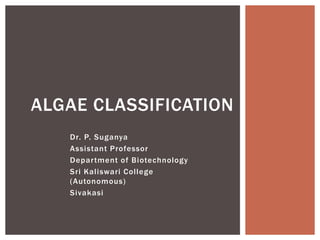
Algae classification
- 1. Dr. P. Suganya Assistant Professor Department of Biotechnology Sri Kaliswari College (Autonomous) Sivakasi ALGAE CLASSIFICATION
- 2. Linnaeus in 1753 was first to introduced the term algae (Latin- seaweeds) meaning, the Hepaticeae. The algae (singular: alga) many of which are are unicellular. Algae are ubiquitous, most of algae lives in aquatic environment but many also thrive a terrestrial and a subterranean alga. Algae contains chlorophyll and are photosynthetic. algae are of great general interest to all biologist because single algal cells are complete organism capable of photosynthesis and the synthesis of a multitude of other compounds which constitutes the cell. The branch that deals with the study of algae are known as as phycology. Algae chlorophyll bearing thalloid. INTRODUCTION
- 3. Algae are present everywhere in distribution. They occur in great abundance in oceans, seas, ponds, fresh water, steams and Salt Lake. Many are found in soil of dam, rocks, stones, and bark of tree and on other animals and plants surface. Small aquatic forms make a large of the free floating microscopic life in water, called plankton. Phytoplankton is made up of plants i.e. algal forms. Zooplankton is composed of animal organisms. Some Species of algae grow on the snow and ice of polar region and mountain peaks. Some, algae grow in hot springes at temperature has high as 55°C. Some are Endophytice. They are not free living but live in other organisms such algae are widespread in protozoa, molluscus, sponges and corals. OCCURRENCE
- 5. Morphology Algae have a wide range of size and shapes. Algae that occur as unicellular and they are spherical, rod-shaped, club-shaped, or spindle shaped. Many are multicellular and have understandable form, shape and various complexity. Algal cells are eukaryotic. In most of the algal species cell wall is very rigid and thin. Cell wall of diatoms are contain silica which makes them thick and rigid. The motile algae have flexible cell membrane called Periplasts. eg. Spirulina. Algae contains a discrete nucleus. Chlorophyll and other pigments are found in membrane bound organelles known as Chloroplast. Within the plastid matrix or stroma are found flattened membranes vesicles called Thylakoid. CHARACTERISTICS
- 6. Algal pigments There are three kinds of photosynthetic pigments are present in algae: chlorophyll carotenoid biloproteins or phycobilins
- 7. Chlorophyll There are five chlorophylls: A, B, C, D and Chlorophyll A is present in all algae. Chlorophyll B – Euglenophycophyta, Cholorophycophyta. Chlorophyll C– Xanthophycophyta, Bacillariophycophyta, Chrysophycophyta, Cryptophycophyta. Chlorophyll D – Rhodophycophyta Chlorophyll E – Xanthophycophyta.
- 8. Carotenoids There are two kinds of carotenoids: Carotenes – linear, unsaturated hydrocarbon. Xanthophyll – oxygenated derivatives. Biloproteins or phycobilins It is water soluble pigments. Present in Rhodophycophyta. Two types of phycobilins – Phycocyanin, Phycoerythrin
- 9. The are three main groups of algae being: Green algae Red algae Brown algae. They are classified on the basis of following characteristics: Primary photosynthetic pigments. Storage product. Cell wall composition. Type and location of flagella. CLASSIFICATION OF ALAGE
- 11. Habitat – Freshwater, Marine and terrestrial. Photosynthetic pigments- Chlorophyll A and B carotenoid. Cell wall components- Cellulose. Storage food- Starch (stored inside the plastids). Flagella- Two flagella per cell. Asexual reproduction- reproduce vegetatively by fermentation or by formation of mitospores. Sexual reproduction- reproduction is of Isogamous, Anisogamous, Oogamous. Example- Chlamydomonas, Volvox, ulothrix, chara, ulva (sea lettuce). Example- Chlamydomonas, Volvox, ulothrix, chara, ulva (sea lettuce). GREEN ALGAE – CHLOROPHYCEAE
- 13. Habitat- Marine and freshwater. Photosynthetic pigment- Chlorophyll A and D, carotenoids and phycobilins. Commonly called red alage because of presence of red pigment – phycoerythrin. Cell wall components- Cellulose Stored food- Floridian starch (alpha -1,4 glucon) stored in cytosol. Flagella- Absent. Asexual reproduction- By fragmentation or by non-motile mitospores. Sexual reproduction- Oogamous and gametes are non- motile. Example – Polysiphoria, Gracilaria and Gelidium. RED ALGAE – RHODOPHYCEAE
- 15. Habitat- marine and freshwater. Photosynthetic pigment- chlorophyll A and C, carotenoids and phycobilins. Shades of brown depends on xanthophyll pigment, fucoxanthin, present. Cell wall components- cellulose and alginic acid. Cellulose is covered by a gelatinous coating of Algin. Stored food- Laminarin, mannitol Flagella- 2, unequal, lateral. Asexual reproduction- by fragmentation or by motile zoospores. Sexual reproduction- is isogamous, anisogamous, Oogamous. Example – Ectocarpus, Laminaria, fucus. BROWN ALGAE – PHAEOPHYCEAE
- 17. Algae as primary producers- algae provides the base or beginning of most aquatic animals or organisms because of their photosynthetic activities so it is also known as primary producers of organic matter. Commercial products from algae- many products are derived from algal cell wall for economic value. Three of these are: Agar Alginic Acid, and Carrageenan, are produced from the walls of algae. Carrageenan is produced from the walls of several red algae. Species of Chondrus, Gigartina are mostly used. Agar is well known as a solidifying agent in the preparation of microbiological media. It is obtained from red algae. Species of Gelidium and Gracilaria are extensively used. Alginic acid and its salts are obtained from the wall for brown algae. Species of brown algae producing this compound include- Macrocystis, Laminaria, Fucus. Algae as food- many species of algae are (mostly red and brown algae) are used as food in the far east. Red algae one of the most important is Porphyra: it is used as food in Japan where it is called Other red algae such as Chondrus, Nemalion are locally collected and prepared. ECONOMIC IMPORTANCE OF ALGAE
